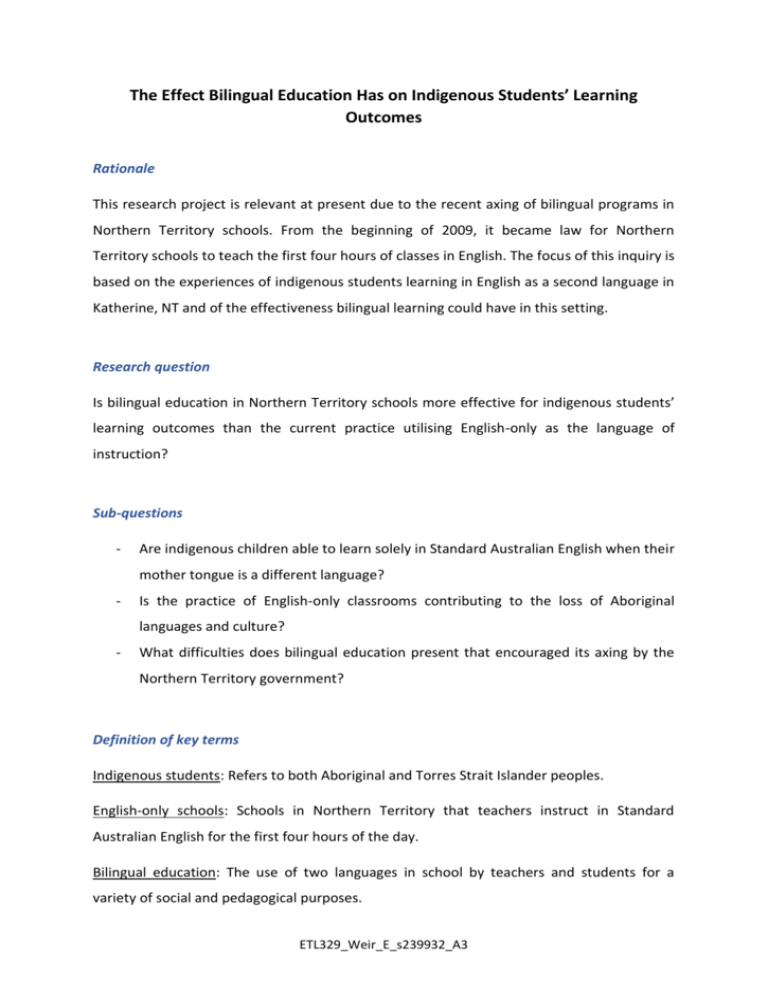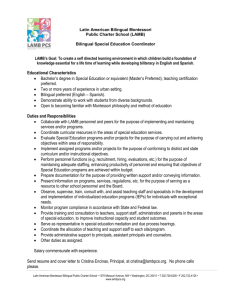The Effect Bilingual Education Has on Indigenous Students
advertisement

The Effect Bilingual Education Has on Indigenous Students’ Learning Outcomes Rationale This research project is relevant at present due to the recent axing of bilingual programs in Northern Territory schools. From the beginning of 2009, it became law for Northern Territory schools to teach the first four hours of classes in English. The focus of this inquiry is based on the experiences of indigenous students learning in English as a second language in Katherine, NT and of the effectiveness bilingual learning could have in this setting. Research question Is bilingual education in Northern Territory schools more effective for indigenous students’ learning outcomes than the current practice utilising English-only as the language of instruction? Sub-questions - Are indigenous children able to learn solely in Standard Australian English when their mother tongue is a different language? - Is the practice of English-only classrooms contributing to the loss of Aboriginal languages and culture? - What difficulties does bilingual education present that encouraged its axing by the Northern Territory government? Definition of key terms Indigenous students: Refers to both Aboriginal and Torres Strait Islander peoples. English-only schools: Schools in Northern Territory that teachers instruct in Standard Australian English for the first four hours of the day. Bilingual education: The use of two languages in school by teachers and students for a variety of social and pedagogical purposes. ETL329_Weir_E_s239932_A3 Methodology This research project will source information through a variety of qualitative research methods, including participant observation, in combination with quantitative research sourced through a variety of texts and online journals. The present situation of indigenous learners’ education in the Northern Territory is presented from a participant-observer perspective which was gained through a one month teaching placement in a primary school in Katherine, NT, and through the experiences and understanding shared with students from the school. Narrative Indigenous and Torres Strait Islander people, as the traditional first settlers in Australia, have for all of history been presented with many difficulties when forced to conform to the language, cultural ways and social economics of “white Australia”. The bilingual programs that had been operating within the Northern Territory since the 1970’s were a celebration of Aboriginal/Torres Strait Islander Australians and white Australians linking in an approach to bridge the gap and improve educational learning outcomes for all indigenous peoples (Devlin, 2009). Now that schools in Australia are without these programs, I sympathize for those students going to school being spoken to in a foreign language (English) and expected to understand and act on these alien words. I appreciate that some studies have represented young children as capable of learning a new language, one that is not spoken in their mother tongue, however that is not the question here. The question in focus for this research project is whether bilingual education is the most effective mode of learning and achieving success for indigenous students. This research report has been carried out to explore Indigenous and Torres Strait Islander students’ educational outcomes since the recent axing in 2009 of bilingual programs in the Northern Territory and whether this was a move that will generate improvement to the success of Indigenous learners. ETL329_Weir_E_s239932_A3 Relevant Literature Research heavily outlines the benefits of children learning best when taught through their mother tongue and of the prolific effects on children’s cognitive development when exercising bilingual skills (Caffery, Simpson & McConvell, 2009). In the report ‘A Share in the Future’, a Review of Indigenous Education in the Northern Territory, written by Bruce Wilson and addressed to the Northern Territory Minister for Education, Honourable Peter Chandler, it was recognised that a key factor affecting Indigenous children in the Northern Territory is the amount of students beginning school with very basic or no English. The review supports the incorporation of first languages in student learning to scaffold literacy learning firstly in the mother tongue language and then as a bridge to access English. It outlines the importance of first language and culture in the school environment, as together they shape identity formation, are integral elements in child engagement, assist students to feel comfortable in the school setting and have essential pedagogical value in the process of learning English. Further literature to support the use of bilingual education involves the study of over two thousand English Language Learners that came from a Spanish-speaking background. Ramirez, David, Yuen, Sandra, Ramey & Dena (1991) carried out a four year study in nine different school districts in California, US, tracking the development of their English understanding. The study showed that bilingual programs that were structured to slowly shift towards English, rather than fast paced and English-only programs, had considerably greater results than the latter. Ramirez et al found that students in late-exit programs achieved greater results in areas of learning than students in early-exit programs. Looking at this information, it can be concluded that students that spend more time learning through their mother-tongue language have more success in their learning outcomes. It is noted that students who improve their reading and writing skills in their own culture are most likely to do well academically when transitioning to English (Ramirez et al., 1991). ETL329_Weir_E_s239932_A3 A study in Florida backs up the findings found by Ramirez et al (1991), where comparisons were made between 952 students that were registered in English and bilingual syllabuses. Bilingual students were found to have scored higher in English literacy by the time they reached the second grade (Oller and Eilers 2000). Further research to confirm findings from above studies include research carried out by Thomas and Collier (2002). It was determined that English Language Learners performed better in programs that had a heavy focus on the development of native language. It was also found in the study that occurred in Houston, US, that children that possess English as their first language were effectively able to learn a second language in the same bilingual focused programs. Findings Findings sourced from observations throughout personal professional experience in a Katherine primary school determine that language barriers are present on a daily basis in an English-only school where the majority of students attending the school are indigenous or Torres Strait Islander. It was observed that the sample of both male and female indigenous children in Year five at Clyde Fenton Primary School were not working at a Year five level in literacy and numeracy. Literacy lessons were taught explicitly to students where reading, writing basic sentences and spelling sight words was the main focus. To observe the sample of students during these lessons it was detected regularly that engagement in lessons was easily lost. Students appeared to not be interested in the English sentences and words that they were working with. Through further investigation with children throughout lessons by means of informal chats and questioning, it appeared that students did not fully understand many of the meanings of words they were spelling or saying. ETL329_Weir_E_s239932_A3 Discussion Bilingual education makes the most sense where the aim is to achieve improved outcomes in non-English-speaking students. Classrooms that remove foreign languages from students’ learning are increasing the likelihood of students falling behind and not being able to integrate English into their education. The unfortunate trend that is occurring now is where students are losing their native languages as they are forced to adapt to the English language with little regard to their individual culture and language background. A solid understanding of English is crucial for Indigenous students to ensure they have access to important opportunities later in life that includes employment, health and safety and food and shelter (Devlin, 2009). It seems that the issues when it comes to bilingual learning are always the same; classes do not have access to culturally appropriate resources, students are not in regular attendance at school, fully trained English as a Second Language teachers are not common and a shortage of bilingual teachers is ever present (Cardenas 1993). Implications The main difficulty arising in this research project is sourcing suitable online resources, such as journals and online texts, which specifically target bilingual education in the Northern Territory of Australia. Much of the information located discusses bilingualism in other regions of the world, which in some ways can support the research here, but is not entirely applicable to this study. Future action recommended from the outcomes of this particular study suggest that the following advice be taken into account in Northern Territory primary schools: 1. Indigenous teachers/assistants to be available to every classroom. 2. Stronger focus on literacy through the mother tongue language before integrating Standard Australian English. 3. Development of teachers’ skills in teaching English Language Learners. 4. Use the two languages to stimulate learners’ cognitive and academic growth. ETL329_Weir_E_s239932_A3 Conclusion The future of bilingual education in Australia is unknown and the difficulty to layout and prepare bilingual educational programs for Indigenous students that have a main focus on their native language is a concern. A wide amount of research has successfully detailed the positive effects of bilingual education, yet still we are not observing and acting on this information. Students in Northern Territory who have grown up in Australia are being ignored by their country and these children deserve the same future and opportunities as all other Australian children. Reflection Upon reflection of this research task, I acknowledge the difficulty in sourcing current and relevant professional information to support the use of bilingual education in Australia. I believe the most beneficial way to build up a precise report detailing the positive benefits of bilingual education in Australia is to follow indigenous students at a range of different schools varying in the teacher instruction, some schools using bilingual and other schools operating in English only lessons. Students should be followed from the beginning of their education journey in year one through to year seven and the long term study would provide rich information that could certainly be compared between schools. The research in this particular study of one small primary school in the Northern Territory provides only a small sample size to make recommendations from. ETL329_Weir_E_s239932_A3 References Caffery, J., Simpson, J. & McConvell, P. (2009). Gaps in Australia’s Indigenous language policy: Dismantling bilingual education in the Northern Territory. AIATSIS Discussion Paper Number 24. Retrieved from http://www.aiatsis.gov.au/_files/research/dp/DP24.pdf Devlin, B. (2009). The Status and Future of Bilingual Education for Remote Indigenous Students in the Northern Territory. Retrieved from webpage URL http://www.nla.gov.au/openpublish/index.php/aral/article/viewFile/2277/2738 Dunbar, R. & Skutnabb-Kangas, T. (2010) Indigenous Children’s Education as Linguistic Genocide and a Crime Against Humanity? A Global View. Gáldu Čála – Journal of Indigenous Peoples Rights No. 1/2010. Retrieved from http://www.fobl.net.au/images/documents /Indigenous_Childrens_Education_as_Linguistic_Genocide.pdf Krashen, S. (2014) Why Bilingual Education? National Association for Bilingual Education, Retrieved from http://www.nabe.org/BilingualEducation Wilson, B. (2013) A Share in the Future, Review of Indigenous Education in the Northern Territory http://www.education.nt.gov.au/__data/assets/pdf_file/0007/37294/A-Share-in-the-Future-The-Review-ofIndigenous-Education-in-the-Northern-Territory.pdf Ramirez, J. David; Yuen, Sandra D.; and Ramey, Dena R. 1991. Final Report: Longitudinal Study of Structured Immersion Strategy, Early-Exit, and Late-Exit Transitional Bilingual Education Programs for LanguageMinority Children. San Mateo, Calif.: Aguirre International. Cárdenas, J. (1993) Intercultural Development Research Association. Current Problems in Bilingual Education: Part I. Retrieved from http://www.idra.org/IDRA_Newsletter/September_1993_Bilingual_Education_Today/ Current_Problems_in_Bilingual_Education%3A_Part_I/. ETL329_Weir_E_s239932_A3






